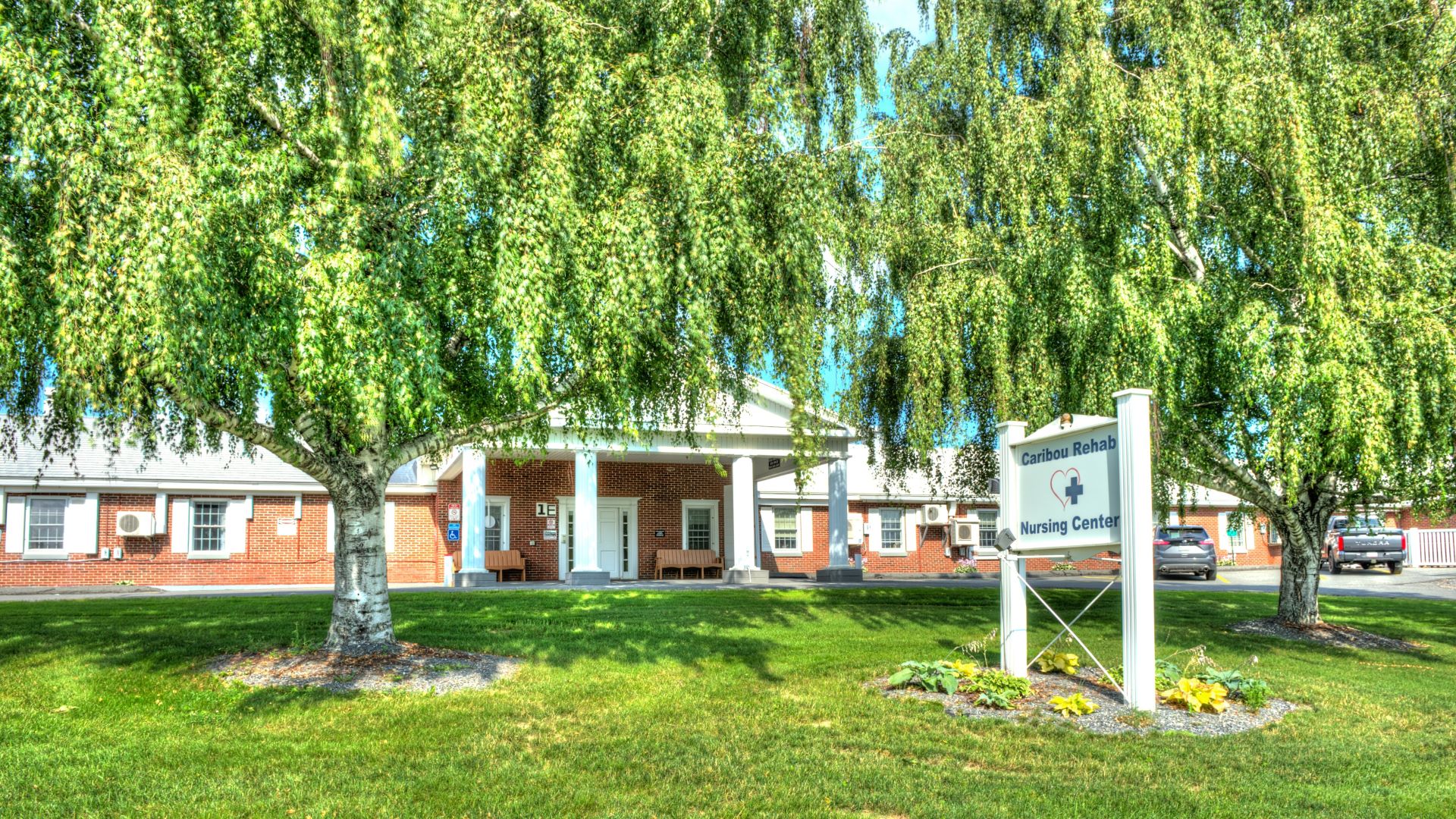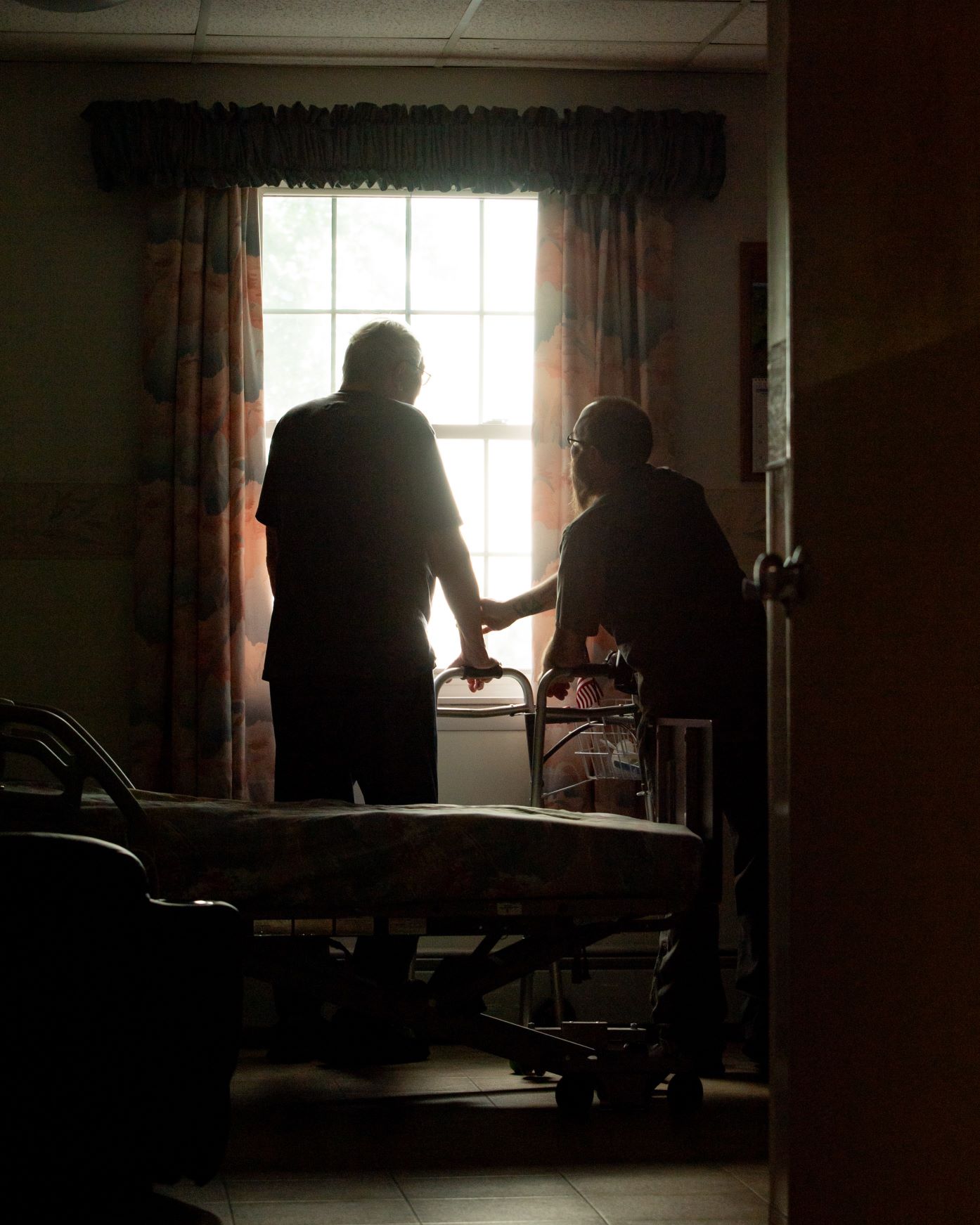As president of Caribou Rehab and Nursing Center, Phil Cyr begins each morning walking the hallways, greeting every employee by name. The walls of the Aroostook County nursing home are full of local historical images compiled by Cyr’s daughter and nature photos taken by his older brother, Paul.
The conference room where new employees are trained is called the “bear’s den,” decorated with photos of black bears that Paul Cyr staged in funny scenarios by luring them with dog food to sit at a picnic table or stand behind a camera tripod. There’s also a fabric black bear head mounted on a wooden plaque. Phil Cyr considered mounting a real bear’s head but the nurses “blew a fuse,” he said ruefully.
On a summer morning, the home was bustling. A physical therapist guided a resident; a worker sorted through clothing; a maintenance employee vacuumed the carpets. In the dementia wing, a resident in a wheelchair greeted Cyr while using his feet to pad forward into his room. “Howdy,” Cyr replied.
The busy atmosphere stemmed in part from the closure of another nursing home owned by the Cyr family, Presque Isle Rehab and Nursing Center, which transferred its last resident this week. Thirty residents and 15 employees moved from Presque Isle to the Caribou facility, with the rest of the residents going to other nearby nursing homes.

The Presque Isle home had been “hemorrhaging” money because it couldn’t find staff and had to operate at 60 percent capacity, Cyr said. From March to May, Cyr estimates it lost $250,000.
“We closed one home to save the other,” he said.
At least 26 nursing homes in the state have closed in the last decade, and there are increasing challenges for family-run facilities competing against large chains. There are currently 79 nursing homes operating in Maine, which has the oldest population in the country.
A recent report from the Federal Reserve Bank of Boston found that since fiscal year 2010, nursing home closures in New England have outpaced the rest of the country — and Maine had the highest rate.
Cyr has been in the nursing home business for nearly 50 years. He and his family at one time owned three of them in northern Maine, with his parents and five siblings all involved in some form. Now he is the only family member in the business and Caribou is the only facility still operating.
That may not be true for long. Cyr openly talks about selling the Caribou facility and getting out of the business altogether. He says running a nursing home has become increasingly difficult due to complex regulations, statewide staffing shortages and low reimbursement rates.
In the 1970s, Caribou made about $150,000 in profit annually, which is more than $800,000 in today’s dollars. Now, Cyr said, it’s a challenge to break even, noting he recently took out a more than $1 million mortgage on the Presque Isle facility to recoup the losses from both homes.
Maine is in the process of reforming its nursing home reimbursement rates. The changes, set to take effect in January, are intended to update how nursing homes get paid while incentivizing better quality care, higher occupancy levels and reduced reliance on temporary staff. The approach includes tying some portion of the payment to staffing levels, clinical outcomes, resident satisfaction and high MaineCare utilization.
The current state budget includes $39 million in allocations for the rate reform effort and an additional $72.8 million as part of a three-year transition fund.
To Cyr, the allocations haven’t made up for what he sees as years of underfunding nursing homes while increasing regulations. He thinks the new requirements proposed through the rate reform effort could force more nursing homes to close.
“Today no businessman in his right mind would get into this business,” he said.
‘Coming soon: a new nursing home’
Cyr, who is 69, didn’t plan to be in the nursing home business for nearly five decades.
He and his five siblings grew up four miles outside Van Buren, on the Canadian border, where his father was a potato farmer for 22 years. But business was tough then, and Phil Cyr and his older brother made it clear they did not want to be farmers, so their father, Albert Cyr, turned to other prospects.
Caribou didn’t have a nursing home, but a local church had been trying to build one and had installed a sign outside town proclaiming “Coming soon: a new nursing home.”
Cyr said his father drove by that sign for about five years before deciding to take it on himself. Two acquaintances had found success opening nursing homes after leaving careers in drywall and construction.
“If they can do it, then a potato farmer should be able to do it,” Cyr said of his father’s attitude.

In 1973 — the year Phil Cyr graduated from high school — his father opened Caribou Rehab and Nursing. Phil graduated from the University of Maine at Machias with an accounting degree. He had his eye on graduate school but his dad needed him as a bookkeeper, so instead he started working at the facility in 1976 and became the administrator the following year.
Cyr took a break from running nursing homes from 1986 to 1996 to run a home care agency, then returned to Caribou as the administrator, serving in that role up until handing the reins to the current administrator, Doug Hise, last year.
Cyr said he may have been the longest-serving administrator in the state: His license number is 346; Hise’s is around 2,900.
Wearing a polo tucked into slacks and wire-rimmed glasses, Cyr is serious and efficient, but quick with a wry grin. When he’s making a point, he pushes his glasses up onto his forehead, piercing blue eyes intently alert. Employees describe him as stern and compassionate.
“In high school I was scared to death of him,” said Lori Caron, the staff educator who started working there in 1980 while still a student. “But he’d do anything to help anybody.”
Cyr got his work ethic from his father, a “workhorse.” Albert Cyr worked from 6 a.m. to 6 p.m., six days a week. He was a devout Catholic and thought life’s greatest joy was working, Phil Cyr said.
“You couldn’t match him,” Cyr said. “He told me ‘After creating heaven and earth, God took one day off. We’re no better.’ ”
At its largest, in 1982, Caribou Rehab and Nursing had 110 beds. The facility now has 67 but will add five in October to help accommodate the residents from Presque Isle.
The decrease in beds over time stems from the state’s decision in the 1990s to reduce reliance on nursing homes and save them for those with only the highest medical needs.
“I think it was the right call, in hindsight,” Cyr said.


Caribou is rated four out of five stars by the U.S. Centers for Medicare and Medicaid Services, which regulates nursing homes. It is one of the 26 Maine nursing homes with four or more stars, based on health inspections, staffing and quality measures.
Brittany Trombley, who started working at Caribou Rehab and Nursing right out of high school and has been there 17 years, said most residents have a personal connection to somebody on staff. Her grandma’s best friend, an aunt by marriage, is a resident. Her grandma, two aunts, mom, cousin and sister-in-law have worked at the facility.
“I would put any of my family members here,” she said, then added, “This is the only place I’d put them.”
Sandra Gagnon, a 76-year-old resident at Caribou whose granddaughter recently started working at the facility, said she was grateful to have a nursing home in the community she grew up in.
“It’s a good thing we have it. Where would we go?” she said. “This is my home. This is where I’m going to die.”
‘A less viable model’
As operating costs have ballooned and regulations have grown in recent decades, the nursing home industry has seen many closures and increasing consolidation.
Running a family-operated nursing home is becoming “a less viable model,” said Mary Lou Ciolfi, senior program manager for the University of Maine Center on Aging, and co-director of the Consortium for Aging Policy Research & Analysis.
There are numerous factors contributing to the rising costs: regulations have become increasingly complex, requiring facilities to frequently audit themselves; resident expectations have evolved, requiring a greater range of care options and amenities; and staff must be kept up to date on more and more training opportunities.
“It’s all good,” Ciolfi said. “It’s all super expensive.”
While increasing costs affect all nursing homes, they’re particularly hard on stand-alone homes because costs can’t be spread across multiple facilities, Ciolfi said.
This is unfortunate because stand-alone facilities are often better-equipped to provide “person-centered care” since they have more flexibility to meet residents’ needs and preferences, said Ciolfi, who also sits on the DHHS Nursing Facility & Residential Care Innovation & Quality Advisory Council.
A recent report published by the Federal Reserve Bank of Boston found that more than half of Maine’s nursing homes were operating at a loss at the end of fiscal year 2023, with some at a loss of more than 10 percent.

“In 2023, low reimbursement rates from Medicaid and Medicare and high operating costs resulted in most nursing homes in New England losing money, suggesting the region could see more closures unless significant changes occur,” said Riley Sullivan, senior policy analyst with the New England Public Policy Center and author of the report.
In the 1980s and early 1990s, states were required to pay long-term care providers rates that were “reasonable and adequate to meet the costs that must be incurred by efficiently and economically operated facilities.” That law was repealed in 1997 and replaced with another that gave states more freedom to set their own rates for nursing homes.
Sullivan cited a 2023 report from the Medicaid and CHIP Payment and Access Commission that found the median Medicaid reimbursement rate nationally covered 86 percent of costs reported by facilities.
According to DHHS, the daily cost per resident in Maine in 2022 averaged $342 and the daily reimbursement rates from MaineCare, the state’s version of Medicaid, averaged $306.
Lindsay Hammes, spokesperson for the Maine Department of Health and Human Services, said much of the “unusually high cost” that year was due to high use of temporary contract staff, adding that nursing home costs can vary greatly between facilities. She said the rate reform effort will bring reimbursement closer to the average cost of care per day.
Changing reimbursement rates
This year, Maine is undergoing a regular rate reform effort that will update reimbursement rate amounts and payment models, which are set to take effect in January.
The state has said it aims to ensure rates keep pace with changing costs of care and to reduce the administrative burden for providers and DHHS, while also providing incentives for better care by linking some payments to a facility’s performance.
The new rate reform effort is intended to improve care by rewarding facilities for metrics such as low rates of antipsychotic medication, few emergency room visits, high staff levels and positive resident reviews.
Hammes, with DHHS, said the new model is centered around supporting higher staffing hours and wage levels for nurses and nursing assistants.
“The new rates represent a significant investment over existing rates, assume competitive wage levels for staff, and include appropriate incentives for expanded access and improved quality,” Hammes said.
Historically, nursing homes have been reimbursed for some costs at the end of each fiscal year, but this could change under the proposed rate reform.
“Cost settlement does not reward efficiency and tends to result in greater variation in costs between facilities, regardless of the quality of care, which we have observed,” Hammes said. “This is why the prospective design of the new rate model, which eliminates cost settlement for direct and routine costs and rewards quality, is important, and will give providers much more predictability of revenue and flexibility in use of the revenue as conditions on the ground change.”

Ciolfi, with the University of Maine Center on Aging, said the state recognizes it needs to be a good steward of public funds, and so if it’s going to increase reimbursement, it also needs to work on improving quality of care.
“We have to do something as a society to improve care,” she said. “This is a start.”
Ciolfi said effective regulations are not punitive, but rather help facilities improve their operations through additional resources, technical support and best practices.
“The issue for state and federal government is how can we create regulations that support long-term care communities in meeting more than the minimum standard, and … still pay everybody,” Ciolfi said.
Angela Cole Westhoff, president and CEO of the Maine Health Care Association, which represents Maine nursing homes, said the new model “promises to be less administratively burdensome for providers and could bring some predictability to rates.”
She added, however, that there isn’t enough information to understand the full impact of the rate reform.
Ben Hawkins, director of public affairs for the Maine Health Care Association, said the effort to improve care is “commendable,” but he was concerned that the proposed value-based payment model is “punitive” and might not improve results.
“MHCA remains concerned about sustaining access to long-term care across the state and that more facility closures will occur if reimbursement rates continue to not keep pace with unavoidable cost increases,” Cole Westhoff said.

Currently, nursing homes that fall below 80 or 85 percent occupancy, depending on facility size, are reimbursed for a reduced portion of their fixed costs, which include things like building equipment, insurance and property tax.
Under the proposed new system, nursing homes with occupancy under 85 percent will receive a lower overall reimbursement, including for routine and direct care costs. If a nursing home achieves higher occupancy, the rates will be more and the facility can reinvest those dollars elsewhere.
“Maine has about 900 empty nursing home beds,” Hammes said. “The quickest and most efficient way to improve access to nursing homes is to increase occupancy and fill some of those beds. This would expand access to care and benefit providers financially, since their costs per resident go down as occupancy goes up.”
The average occupancy rate for Maine nursing homes was about 85 percent last April, with 27 facilities below that threshold, “which is why the proposed change is so troubling for many operators,” said Hawkins.
‘A mac and cheese budget’
To Cyr, the occupancy requirements are unrealistic, and other aspects of the rate reform effort will be difficult to achieve.
Last year, Caribou Rehab and Nursing reached 89 percent occupancy, Cyr said. On an old-fashioned punch calculator, Cyr calculated if his occupancy had fallen below 85 percent, he would have been on the hook for an additional $157,000.
The influx of residents from Presque Isle Rehab and Nursing’s closure could help Caribou Rehab and Nursing’s occupancy this year, but the facility is on track to barely make the threshold at 85.5 percent occupancy by the end of the fiscal year in September.
Nursing homes are also grappling with lower income from rehab services that haven’t rebounded after the pandemic and a decreasing number of private-pay residents, Cyr said.


He sees increasing regulations as hindering the operations of nursing homes trying their best, but when pushed he acknowledged that some regulations are necessary to keep “unscrupulous” operators in check. It comes down to the owner’s philosophy, he said.
“The time when regulations are bad is when complying is not achievable,” he said. He pointed to the recent federal regulation that nursing homes have a registered nurse on duty at all times, saying this is difficult to achieve when there’s a shortage of nurses nationally and no additional funding to support the requirement.
“They have a lot of desirable goals but if you do not pay facilities sufficiently, you’ll never achieve those goals,” Cyr said. “You can’t serve burgers if you have a mac and cheese budget.”
As an employee was coming down the hall with a cart, Cyr ducked into an empty doorway. Asked if selling Caribou would mean a quiet retirement, Cyr shook his head.
He said he wants to continue advocating for nursing homes and is considering running for the state legislature.
“You have to keep moving,” Cyr said. “If you stop moving, you die.”







